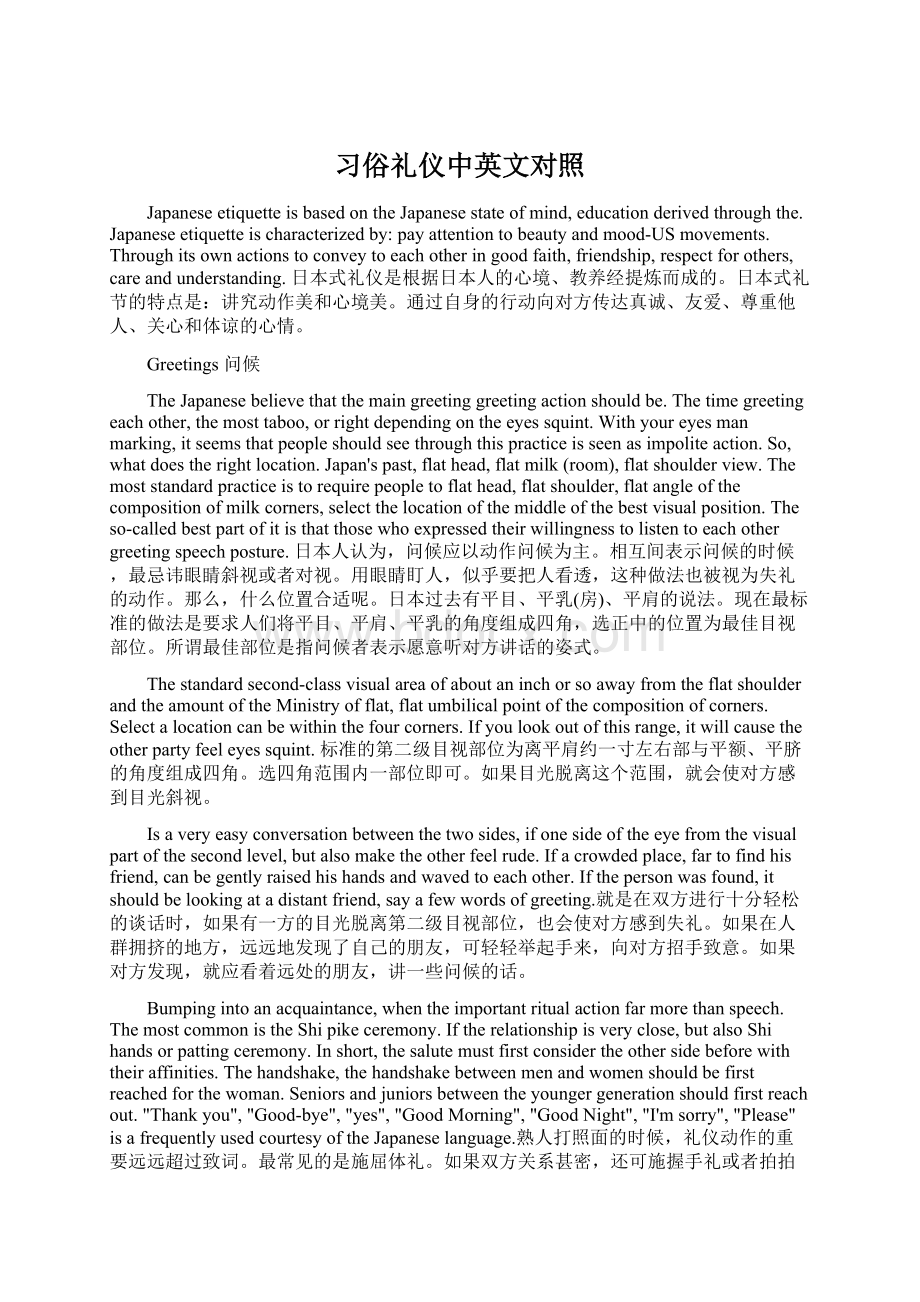 习俗礼仪中英文对照Word文件下载.docx
习俗礼仪中英文对照Word文件下载.docx
- 文档编号:21384978
- 上传时间:2023-01-30
- 格式:DOCX
- 页数:15
- 大小:35.74KB
习俗礼仪中英文对照Word文件下载.docx
《习俗礼仪中英文对照Word文件下载.docx》由会员分享,可在线阅读,更多相关《习俗礼仪中英文对照Word文件下载.docx(15页珍藏版)》请在冰豆网上搜索。

相互间表示问候的时候,最忌讳眼睛斜视或者对视。
用眼睛盯人,似乎要把人看透,这种做法也被视为失礼的动作。
那么,什么位置合适呢。
日本过去有平目、平乳(房)、平肩的说法。
现在最标准的做法是要求人们将平目、平肩、平乳的角度组成四角,选正中的位置为最佳目视部位。
所谓最佳部位是指问候者表示愿意听对方讲话的姿式。
Thestandardsecond-classvisualareaofaboutaninchorsoawayfromtheflatshoulderandtheamountoftheMinistryofflat,flatumbilicalpointofthecompositionofcorners.Selectalocationcanbewithinthefourcorners.Ifyoulookoutofthisrange,itwillcausetheotherpartyfeeleyessquint.标准的第二级目视部位为离平肩约一寸左右部与平额、平脐的角度组成四角。
选四角范围内一部位即可。
如果目光脱离这个范围,就会使对方感到目光斜视。
Isaveryeasyconversationbetweenthetwosides,ifonesideoftheeyefromthevisualpartofthesecondlevel,butalsomaketheotherfeelrude.Ifacrowdedplace,fartofindhisfriend,canbegentlyraisedhishandsandwavedtoeachother.Ifthepersonwasfound,itshouldbelookingatadistantfriend,sayafewwordsofgreeting.就是在双方进行十分轻松的谈话时,如果有一方的目光脱离第二级目视部位,也会使对方感到失礼。
如果在人群拥挤的地方,远远地发现了自己的朋友,可轻轻举起手来,向对方招手致意。
如果对方发现,就应看着远处的朋友,讲一些问候的话。
Bumpingintoanacquaintance,whentheimportantritualactionfarmorethanspeech.ThemostcommonistheShipikeceremony.Iftherelationshipisveryclose,butalsoShihandsorpattingceremony.Inshort,thesalutemustfirstconsidertheothersidebeforewiththeiraffinities.Thehandshake,thehandshakebetweenmenandwomenshouldbefirstreachedforthewoman.Seniorsandjuniorsbetweentheyoungergenerationshouldfirstreachout."
Thankyou"
"
Good-bye"
yes"
GoodMorning"
GoodNight"
I'
msorry"
Please"
isafrequentlyusedcourtesyoftheJapaneselanguage.熟人打照面的时候,礼仪动作的重要远远超过致词。
最常见的是施屈体礼。
如果双方关系甚密,还可施握手礼或者拍拍肩膀。
总之,施礼之前必须首先考虑对方与自己的亲疏关系。
就握手而言,男女之间握手,应由女方首先伸手。
前辈、晚辈之间,则应晚辈首先伸手。
“谢谢”、“再见”、“是”、“早安”、“晚安”、“对不起”、“请”是日本人经常使用的礼貌语言。
JapanesepopulationisalmostnooneeverWuzhou.Itappearedonlyinrecentyears,"
he"
and"
her"
argument.Undernormalcircumstances,honorificscompletelyreplacedbytheperson.Therefore,theproperuseofhonorificsisessentialfortheJapanese.Inprinciple,totalkabouttherelationshipbetweenthemselvesorwiththeirclosestpersontouseself-deprecatinglanguage.Ontherelationshipwitheachotherwhenclosetopeopleandseniorstousehonorifics.Thosewhorespectfullyandindiscriminateuseofhonorifics,orevenmakingthingswhenIusethehonorificotherswhowouldberegardedaslackinginupbringing.ItcanbesaidwhethertheproperuseoflanguageinJapanisoftenjudgeapersonuneducatedimportantbasis.Withacquaintancesinthemiddleoftheroadoratthestationticketgatetotalkaboutlong-distance,onthetramfortheiracquaintancestoletothersarerudetheperformanceofyourseat.Inpublicplaces,theJapanesestressedtheneedtofirstconsiderthe"
Donottroubletoothers."
Therefore,peopleoftentalkaboutlookingforlong-distancecallornottoinfluenceotherstowalktheroadsidelocation.Inaddition,notonlyconsidertheirown,regardlessoftheother,atastetotalkaMeiWan.Japanesethinkitisalackofrespectfortheperformanceofothers.日本语口浯中几乎没有人称。
只是近年来才出现了“他”与“她”的说法。
在一般情况下,敬语完全取代了人称。
因此,正确使用敬语对于日本人来说至关重要。
原则上谈自己或者与自己关系亲近的人时要用自谦语。
谈与对方关系亲近的人及前辈时要使用敬语。
那些恭恭敬敬地胡乱使用敬语,甚至提本人的事时也使用敬语的人会被旁人视为缺乏教养。
可以说,在日本能否正确使用语言往往是判断一个人有没有教养的重要根据。
与熟人在道路中间或者在车站检票口谈长话,在电车上让别人为自己的熟人让座都是失礼的表现。
在公共场合,日本人强调必须首先考虑“不要给别人添麻烦”。
因此,人们谈长话时往往寻找路边或者不影响他人行走的地点。
此外,不能只考虑自己,不顾对方,一味儿地聊个没完。
日本人认为这是一种不尊重他人的表现。
Encounteredonthestreetelders,superiors,eventhoughthereisnoneedtotakeofftheircoats,butitmustbeeasytotakeoffthehat,glovesoff,andthensalute.Takingintoaccountthetrafficproblems,mustbeelders,superiorssothattobeabletosheltertheirlocation.Takingfullaccountofeachother'
scircumstances,togreetings,butmustpayattentiontosimpleandconcise.在大街上遇到长辈、上司,尽管没有必要脱下大衣,但必须将容易脱掉的帽子、手套摘下,然后施礼。
考虑到交通上的问题,必须把长辈、上司让到能够庇护他们的地点。
在充分考虑对方的情况下,进行问候,但一定要注意简单、扼要。
Properuseoflanguageisanart.Speakofthevoice,tone,speed,pronunciationtalkdirectlyaffecttheresults.Undernormalcircumstances,talktouser-friendly,givingeachotherapleasantfeelingasgood,toodirtyortoohigh-tonetendtohindertheindividual'
simage.Inparticular,notethatwhengreetingeachotherasfaraspossiblenottousewiththeirprofessional,highlyjob-relatedvocabulary,soasnottounderstandeachother.Thensaysomethingprofoundtruth,othersdonotthinkpeoplegreatconversation.Thetopicofreligionandpoliticsofteninvolvepersonalposition,thussuchwordsaslittleaspossiblereachandeasilytalkabouttheeventsofthatdayisstillpossible.Generallyspeaking,witheachothertotalkaboutliterature,art,sportstopics,theobstacleswillbeless,butforbiddentoeachothertoexpresstheirerudition.Inaddition,theexcessiveuseofspeakingotherlanguagesarealsouneducatedperformance.Standardpracticeistofirstaccordingtotheirsituation(age,gender)forthecorrespondingtopic,theuseofeducatedlanguage,easytotalkto.TheJapanesebelievethat,regardlessofapersonlearninghavecontributedmuch,ifnotunderstandawiderangeofsocialknowledge,unreasonablewaysoftheworldarenoteducatedpeople.正确使用语言是一种艺术。
说话时的声音、口气、速度、发音等直接影响谈话效果。
一般情况下,谈话以通俗易懂、给对方以愉快的感觉为好,过分卑下或者过分高腔调都有碍个人的形象。
特别要注意的是,问候对方时尽量不要使用与自己的专业、职务有关的高深的词汇,以免对方费解。
这时讲一些高深的道理,旁人并不会觉得谈话人了不起。
宗教与政治的话题往往涉及个人的立场,所以这类话尽可能少触及,轻松地谈一谈当天发生的事件还是可以的。
一般说来,与对方谈文学、艺术、体育方面的话题,障碍会少一些,但严禁向对方表示自己的博学。
此外,过多地使用外语交谈也是没有教养的表现。
标准的做法是,首先根据对方的情况(年龄、性别)提出相应的话题,使用有教养的语言,轻松地交谈。
日本人认为,无论一个人在学问上有多大的建树,如果不懂广泛的社会知识,不通世故都不是有教养的人。
Thework,businessrequirementsbriefconversation,thereisorder,focusedandhasnothingtodowiththesubject,thenminimized.Sidetoomuch,toomuchirrelevantifnottransactionallanguage.Beabletoattractlaw-abidingpeopleisathemetothelevelofconversation.TheJapanesesaygoodbyeceremonyistoeachothertoexpresstheirsinceremeans.Japan'
sgoodbyeceremonyforpikemainceremony.InadditiontothespecialintimacythatonlyShishookhandsgoodbyeceremony,butmustpayattentiontotheshiftfromthemeshheads,fromthefirsttothemanaskingforthewoman.Pikeceremonyknownasthebowceremony,infactitisamisunderstanding.Pike-liofthemostparticularabouttheeye,throughtheeyestoconveyhissinceritytoeachother.有关工作、业务方面的谈话要求简明扼要、有顺序、突出重点,与主题无关的话尽量少说。
枝节过多,无关的话过多就不是事务性语言。
能够把听话的人吸引到主题方面来才是有水平的谈话。
日本人的告辞礼是向对方表示自己的诚意的手段。
日本的告辞礼以屈体礼为主。
除表示特别亲热才施握手告辞礼,但必须注意从目上转向目下,由女方首先向男方伸手。
屈体礼被称为低头礼,实际上这是一种误解。
屈体礼最讲究眼神,通过眼神将自己的诚意转达给对方。
Theso-calledPinZhi-li(headfirst,thefirstceremony,sayingthatJian-li,ZhaoJiaLi,foldinghand-ceremony,ceremony,wavinghishandsceremony,co-ordination,togetherinprayerceremony)canbeselectedasappropriateaccordingtotheothersidesaluteseveralways.所谓九品礼(目首、首礼、指建礼、爪甲礼、折手礼、招手礼、双手礼、合手礼、合掌礼)是可以根据对方的情况酌情选用的几种施礼方式。
TheJapaneseemphasisisheart-shapedperformance.Shapedthecourseofcertainrules,itislongpasttheJapaneseexchangestoheartthemostcorrectwayisnottobearbitrarilyaltered.日本人强调形是心的表现。
形的过程有一定的规矩,它是长年来日本人进行心际交流最正确的方法,是不容随便改动的。
Thecorrectactionisbasedonthecorrectposture.So,tomasterthecorrectpostureisveryimportant.OKpikeceremonywhentheactionifnotcareful,willnotbeabletocommunicatetheirfeelingstoeachother.Goodbyeceremonyjustforthebow-lineisfarfromenough.Payattentiontothecorrectpikeceremonyneckstraight,bowtheirheadstomaketheothersidewhenyoucannotseehisownchin,spinewasstraightstate.Inthemeantime,thankstotheotherpartymustcontributewithinnerfeelings.AlthoughthepopulationItgoeswithoutsayinggood-bye,bye,thankyousortofgreetingwords,butthroughtheirownactions,thismoodisbeingcommunicatedtotheotherside.正确的动作的基础是正确的姿式。
所以掌握正确的姿式十分重要。
行屈体礼的时候,动作如有不慎,就不能将自己的心情传达给对方。
仅仅为行告辞礼而低头是远远不够的。
正确的屈体礼讲究脖颈伸直,低头时要使对方看不见自己的下颏,脊梁呈笔直状态。
与此同时,内心必须怀着向对方致谢的心情。
尽管口中不用说再见、再会、谢谢之类的寒暄语,但通过自己的动作,这种意境正传达给对方。
Pike-li-li-licanbedividedintotwokindsofceremonyandprostratedthemselves.屈体礼可分为立礼与跪拜礼两种。
Li-Liarmsnaturalvertical,fingersseparated,mouthopenisrudetoperformance.Fivefingersclosetogetherverticallydown,whenthepikewiththebody'
snaturaldroop.Afterbiddingfarewelltothehigheststandardspikeceremonyisbentuntilthefingerstouchthebodyuntiltheknee.Theminimumspecificationsgoodbyepikeceremonyonlyrequirestraightbodybentforwardfromthewaist.Japanclaimsthattheprincipleofaccommodatingthreetone,thatis,whenthepikeinhale,exhalestopstill.Re-breathingwhenthebodyrecover.
TheJapanesenationknelt-typemodelisauniquelifestyle.SobowdowntotheuniqueceremonyhasbecometheJapaneseetiquette.Inrecentyears,kneltLifeinJapanhavebecomelessfashionable.SomeJapaneseexpertsbelievethatknelttotheJapanesestyl
- 配套讲稿:
如PPT文件的首页显示word图标,表示该PPT已包含配套word讲稿。双击word图标可打开word文档。
- 特殊限制:
部分文档作品中含有的国旗、国徽等图片,仅作为作品整体效果示例展示,禁止商用。设计者仅对作品中独创性部分享有著作权。
- 关 键 词:
- 习俗 礼仪 中英文 对照
 冰豆网所有资源均是用户自行上传分享,仅供网友学习交流,未经上传用户书面授权,请勿作他用。
冰豆网所有资源均是用户自行上传分享,仅供网友学习交流,未经上传用户书面授权,请勿作他用。


 对中国城市家庭的教育投资行为的理论和实证研究.docx
对中国城市家庭的教育投资行为的理论和实证研究.docx
 升级版-中国人保人寿保险职业分类表表格文件下载.xls
升级版-中国人保人寿保险职业分类表表格文件下载.xls
